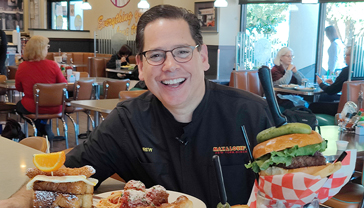When we opened the doors of Max & Louie’s New York Diner, people kept referring to it as a deli. We’ve since given up on making the distinction between a diner and a deli. Because, as a wise man once said, as long as they keep coming back, they can call it anything they want.
To my wife Wendy and me, Max & Louie’s is as close to a traditional East Coast diner as we could create here in our adopted home town of San Antonio. It checks all the boxes of what we miss about New York diners – a huge menu, huge portions of straightforward comfort food, cooked to order, and delivered fast by friendly servers.
But, honestly, it IS a deli too. After all, we slice our own meats, serve overstuffed two-fisted sandwiches with a pickle on the side, sell lots of deli platters for parties and events, and have a long list of traditional deli items on our menu – including things like chopped liver, tuna salad, lox, knishes, blintzes, babka and more.
And it’s all available for dine in or take out.
That means you’re right either way –Max & Louie’s is both a diner and a deli.

So how does Max & Louie’s meet the historical, traditional definition of diners and delis? The answer to that is interesting.
Diners are as American as apple pie. The first diner concept is credited to Walter Scott, and his horse-drawn lunch wagon in Providence, Rhode Island in 1872. He sold lunch to the overnight shift workers because all the other restaurants were closed. He did a booming business – all from the windows of the wagon, and without any seats. Arguably, it’s the first food truck in America too.
Night lunch wagons became so popular in the northeast that soon pre-fab one-room buildings popped up everywhere workers needed them. Walter Scott’s original concept of serving sandwiches, pie and coffee turned into a sit-down experience with a slightly bigger list of offerings. But they remained intimate. The average size of a wagon was 8’X14’ yet the novelty was huge, attracting a range of patrons from workers to aristocrats looking for hearty, simple fare.
The early 1900s began the golden age of seated diners, when they began to look like art deco railroad dining cars. Because the prefab buildings were shipped around the country by rail, the manufacturers designed them to look like a dining car. And now that they had a little kitchen and a grill, the menus grew to include all-American affordable dishes like meatloaf, burgers, sandwiches, eggs, pancakes, and lots and lots of coffee.
Also in the early 1900s, a huge influx of Greek citizens emigrated to the United States. Cafes were part of their culture at home – so owning and running a diner in America was a perfect fit. Since the 1940s, most diners in New York – yes, MOST diners – have been owned by people of Greek descent. Now you know why you’ll almost always find a Greek Salad on a diner menu, including ours.
Immigrants also played a role in delis. As German Jewish immigrants arrived in New York in the late 1800s, they opened kosher delicatessens, selling fresh sliced kosher meats, grocery items, and made-to-order sandwiches that could be eaten at small tables or wrapped to go.
Not long after Jewish delis opened around the city, Jewish appetizing shops began to spring up too – exclusively selling foods made with dairy, smoked fish, and eggs – but not meat. (Remember, Kosher law prohibits the eating or storage of dairy and meat together.) The name “appetizing shop” refers to the items on the menu – all of which can be served on a bagel or other breads – and is a throwback to the tradition of Eastern European Jews who generally started meals with cold appetizers that were NOT meat based. Those immigrants brought their traditions to their new home in America and opened appetizing shops to keep their customs alive.
In the 1930s, there were 500 independently owned appetizing shops in New York City. Now there’s just a handful. And, the number of independent retail Jewish delis in New York City declined too – from a high of about 1,500 in the 1930s, to only 15 in 2015.
Oy. Enough history. Let’s talk about what it all means to YOU.
At Max & Louie’s New York diner in San Antonio you can get appetizing. You can get deli. You can get all-American diner food. You can get breakfast all day. And we don’t care what you call us. Just come in, enjoy our huge menu and generous portions. Let our staff take good care of you. Have a great cup of coffee. And know that everything you’re ordering is part of a long history of delicious dining.
Everything we serve at Max & Louie’s New York Diner has a backstory and a place in our heart. I hope you’ll come in soon and try something new, something nostalgic, or something steeped in tradition.
And while you’re here, ask for me and let me know what you thought of the Diners, Delis and Drew episode of Max & Louie’s TV available in the link below.
I’ll see you soon!
Drew


